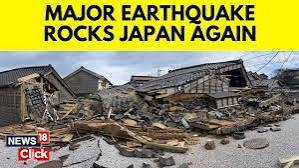Moderate Earthquake Jolts Central Japan, Raises Awareness of Preparedness.
A moderate earthquake struck central Japan on November 27, 2024, underscoring the country’s persistent vulnerability to seismic activity. The quake, which registered a preliminary magnitude of 5.8, hit the region in the early morning hours, shaking cities and towns but causing no immediate reports of significant damage or casualties.
Details of the Seismic Event
According to Japan’s Meteorological Agency (JMA), the earthquake’s epicenter was located off the coast near Shizuoka Prefecture, an area known for its proximity to the tectonic convergence of the Pacific and Philippine Sea plates. The quake occurred at a depth of approximately 40 kilometers, a factor that contributed to the widespread tremors felt in neighboring prefectures, including Tokyo and Nagano.
Residents in Tokyo, about 150 kilometers away from the epicenter, reported mild shaking, while those in closer proximity experienced stronger tremors. Despite the intensity, no tsunami warnings were issued, thanks to the quake's inland epicenter and moderate magnitude.
Historical Context and Seismic Preparedness
Japan is one of the most seismically active nations in the world, accounting for approximately 20% of the world’s earthquakes of magnitude 6.0 or greater. Events like the Great East Japan Earthquake in 2011, which caused catastrophic damage and loss of life, have left an indelible mark on the nation’s approach to earthquake preparedness. In the aftermath of that disaster, Japan fortified its infrastructure, upgraded its early warning systems, and regularly conducts evacuation drills to mitigate risks from future seismic events.
The latest earthquake serves as a reminder of the importance of these measures. Experts note that while the event was moderate in magnitude, it highlights the need for continuous vigilance, particularly in regions like Shizuoka that sit near major fault lines.
Public Reaction and Safety Measures
Following the tremor, local governments swiftly assessed public infrastructure, including bridges, tunnels, and rail systems, to ensure safety. Japan Railways (JR) temporarily suspended operations on the Shinkansen bullet trains to inspect tracks and equipment, resuming service within hours once safety was confirmed. Schools and workplaces in the affected areas conducted routine safety checks and evacuation drills as a precautionary response.
Social media platforms were abuzz with reactions from residents sharing their experiences. Many expressed relief that the quake had not caused severe harm, while others took the opportunity to stress the importance of maintaining emergency kits and staying informed about evacuation routes.
Scientific Implications
Seismologists emphasized the importance of ongoing research into Japan’s complex tectonic environment. The latest earthquake aligns with long-term patterns observed in the region, where smaller tremors often act as precursors to larger seismic events. Scientists are urging residents and authorities not to become complacent, as even moderate earthquakes can sometimes trigger aftershocks or foreshadow more significant seismic activity.
Dr. Hiroshi Tanaka, a leading seismologist at the University of Tokyo, highlighted the role of advanced monitoring systems like Japan’s Earthquake Early Warning (EEW) system. “Our ability to detect and analyze seismic activity in real time has significantly improved, allowing us to alert citizens within seconds of an event,†he explained. “This system saves lives by providing critical moments to take cover or halt transportation systems.â€
Lessons and Takeaways
The November 27 earthquake underscores Japan’s ongoing challenges as a nation situated in a seismically active zone. While no major damage occurred this time, the event is a reminder that preparedness is key to mitigating the potentially devastating impacts of future quakes.
Experts recommend that residents regularly update their emergency kits with water, non-perishable food, flashlights, batteries, and medical supplies. Additionally, they advise participating in community drills and staying informed through reliable sources such as the JMA and local government channels.
This event reinforces the resilience and readiness ingrained in Japanese society—a country that, through its history, has continuously adapted to the challenges posed by its geophysical environment. As seismic monitoring technology advances and public awareness grows, Japan remains a global model for earthquake preparedness and response.


